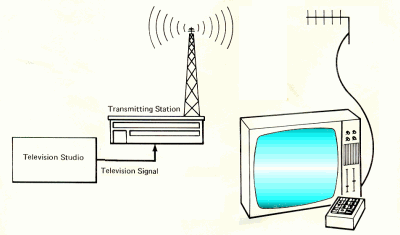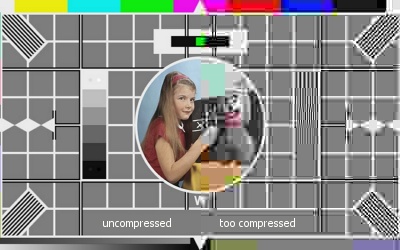Do I need to buy a booster?
 Brian Butterworth published on UK Free TV
Brian Butterworth published on UK Free TV With analogue television, it has often been necessary to buy an amplifier to improve the quality of the television picture, or to supply a steady on several televisions fed from the same aerial.
Many people have asked if it necessary to investing in a signal booster for Freeview.
"Analogue television" means is that the sound and pictures are broadcast using signals that are an "analogue" of the input. The sound and picture are transmitted from the source as electrical signals, then as radio waves and then back to sound and picture again.
In an analogue television camera, the image is scanned 25 times a second from side to side, from top to bottom and back. Where a lot of light is scanned, a high voltage is produced. Where no light is scanned, no voltage is produced. The output voltage is the same ratio to amount of light at scanned.
Leaving aside the technically, this signal is sent to the transmitter. The transmitter emits a radio wave on a known frequency, which is varied by the incoming voltage.

A microphone also converts the sound vibrations it picks up into a voltage, which when sent to the transmitter is added to another radio transmission frequency.
The signals are received by a television aerial pointing at the transmitter and converted back to very weak electrical signals. The sound is amplified and sent to a loudspeaker, and a picture created on the TV screen.
So on an analogue television, if the incoming signal is weak then the picture is dull as the background noise (the snow scene seen when an analogue television is not tuned) makes the picture less watchable.
The best analogue television set equipped with a great TV aerial located near to a high powered transmitter will produce brilliant pictures and clear sound. A poor set with an inadequate aerial or substandard cable will not.
If a weak signal is fed to a booster device, this will make the picture appear better on the television set or sets. It is often worth the investment.
Digital television
In a digital studio, the voltages from the cameras and microphones are not sent directly to the transmitter. It is converted into a stream of numbers inside a computer. The input voltage relates directly to the number in the computer. By sampling the input at a regular frequency, it is therefore possible to both store and transmit the information digitally this is what computers are good at.
It is therefore possible to take these numbers and generate a sound and picture output from them. However, the amount of information generated is over 240Mb/s, 30 times the rate of the fastest broadband connection.
Buy using computational techniques on this information the data can be compressed to as low as 2Mb/s, with as little as 6Mb/s being required for a good quality picture. These data compression techniques are called "lossy" because the reconstructed images are not identical to the originals, but look virtually similar to human eyes.

Digital television uses the same transmission frequencies as analogue uses, known as C21 to C68. The digital data is sent using a system called COFDM (Coded Orthogonal Frequency-Division-Multiplexing) which can carry data at a rate of 18Mb/s or 24Mb/s. Several television channels and some radio stations can be multiplexed together to produce exactly this amount of data.
At the receiver, it must be able to decode every single bit from these transmission multiplexes. A single error is impossible to correct for, so the decoder must have no errors.
Until switchover happens, the Freeview signals are being broadcast at very, very low power levels. However the COFDM system and sensitive digital equipment will, as long as the signal can be found and decoded there will be pixel-perfect reconstruction of the television channel. If the signal is drowned out by interference (especially from analogue transmissions) then no picture or sound will be output.
If the TV aerial installation you have provides you with all the Freeview channels, there is nothing to worry about.
If you are missing some channels because the signal is just too weak the best place to start is by improving the aerial, see Freeview reception - All about aerials. A bigger, higher, better designed aerial will always be the most sensible way to get perfect reception.
If you want to supply a signal to several sets, where the incoming signal is being "split" to serve several Freeview boxes, a masthead amplifier will be effective. This is because the signal is already of good quality and is being repeated for several sets.
However, if you are not getting a good signal from your aerial, a booster by the TV set will probably not help as this will simply boost the background interference as much as the Freeview signal.
In circumstances where an amplifier that has improved a picture on an analogue, it may be unsuitable for Freeview reception. Sometimes they will block one or more multiplex, where disconnecting the amplifier will restore the channels.
8:43 PM
Birmingham
Since the Sutton Coldfield switchover I have lost all subtitles on ITV1 ( all other channels are fine) I have retuned several times but no joy. Is this caused by a weak signal or......?
| link to this comment |
Jo's: mapJ's Freeview map terrainJ's terrain plot wavesJ's frequency data J's Freeview Detailed Coverage
10:16 AM
Birmingham
Jo: I'd already tried that but it hadn't helped. Have now bought an aerial attentuator ( 12db) and that has mainly solved ther problem although BBC prgrammes won't load subtitles ands keep breaking up at times. Will have to try a manual retune for the BBC channels when I have time
| link to this comment |
Jo's: mapJ's Freeview map terrainJ's terrain plot wavesJ's frequency data J's Freeview Detailed Coverage
2:43 PM
kevin standbridge: If your aerial points to Crystal Palace - which it probably does if your switchover date is April 2012 - the problem is probably that Sandy Heath SDN multiplex also uses C31, the same as the pre-switchover HD transmissions from Crystal Palace. It moved to this channel on 31 August. The exact behaviour will depend on how your aerial handles signals from other directions, and the relative propogation of both transmissions (which changes with the weather and with the time of day).
In my opinion, the planners have made a mistake by moving Sandy Heath SDN to C31. It had to move away from the pre-DSO allocation of C43 as that was needed at Sutton Coldfield, but cannot yet take C51 (the final allocation) as that's still needed elsewhere; it had to go somewhere, but I don't think this was a good choice.
| link to this comment |
4:49 PM
Bristol
Hi,
I have just moved into a new house in a new area and I don't seem to have any signal from the TV aerial at all. My TV is about 2 years old, it's a digital TV with built in Freeview. I've tried scanning for new TV channels (on DTV too), but all I get is static.
Do you think this is a problem with the aerial, my TV, do I need a Freeview box of some nature, or am I just being thick?! Any help you give would be appreciated.
Thanks.
| link to this comment |
Jonathan's: mapJ's Freeview map terrainJ's terrain plot wavesJ's frequency data J's Freeview Detailed Coverage
5:24 PM
Jonathan: Are you sure that you are scanning the TV with it set on DVB and not analogue?
Your code indicates various possibilities for reception, the full service transmitters being Mendip(@ 19mls) or Wenvoe(@ 23mls), and Freeview "Light" (limited to PSB only) being Portishead (@ 1ml) or Portbury (@ 2mls)
If you were scanning the TV set on digital (DVB) then it could suggest that there might be a problem with your aerial. (e.g: broken cable / co-ax plug fault etc)
| link to this comment |
10:57 AM
Bristol
Thanks jb38.
I've scanned on the standard setting (analogue I guess) and on DTV (is this the same as DVB?). All I get is static.
There's a satellite dish on the side of the house, but this shouldn't effect the aerial signal coming from the roof, or does it? I've traced the cable from the satellite dish and it seem independent of any other cabling.
Thanks again. Jonathan
| link to this comment |
Jonathan's: mapJ's Freeview map terrainJ's terrain plot wavesJ's frequency data J's Freeview Detailed Coverage
1:24 PM
Jonathan: You are quite correct insomuch that the satellite dish wont affect Freeview reception, and yes! DTV and DVB are the same thing, however the only reason I queried whether or not you had scanned whilst on DTV was because you had mentioned static, as nothing of that nature (white streaks / dots or similar on screen) should ever be seen on a digital TV's screen, that is unless the TV is defective or that there is a problem with the mains power supply to it.
Can you also see what you are referring to as static if you scan without the aerial being connected? because if not and you know for 100% certain that your TV is still OK after your move then its liable to point to a problem with your aerial system, as unless you are situated in a black spot for reception (predictors not being accurate enough to show these) then you should at least get something on a scan, although possibly not Portishead as its a highly directional transmitter with you appearing to be on the wrong side of it.
If you can see your aerial, what way are the elements sitting, vertical or horizontal? because if the aerial was installed to suit your local station they should be vertical, and if facing towards Portishead pointing @ 242 degrees, whereas for Portbury its 124 degrees, Mendip being @ 162 degrees and with Wenvoe @ 265 degrees, the latter two stations requiring the elements to be horizontally mounted.
It would maybe be prudent to enquire with your neighbours if they can receive Freeview, and if they can from where.
| link to this comment |
2:22 PM
Bristol
Thanks again jb38,
We checked with one neighbour who said that they had a poor signal when they first moved in (2 years ago). They said that they had to buy a box (not sure if this is a booster, free view box or what) which improved the signal. Sorry if this is a bit vague, it wasn't me who spoke to them! I'll try and check the aerial alignment tonight if its not too dark.
Thanks for all your help.
| link to this comment |
Jonathan's: mapJ's Freeview map terrainJ's terrain plot wavesJ's frequency data J's Freeview Detailed Coverage
4:18 PM
Jonathan: Yes, try and find out what they meant by box, although if they said it improved the signal then I suspect that its an aerial booster rather than anything else.
Anyway, have a check and give an update on your findings, I would also try and have a look at you neighbours aerials to see if they are all facing the same direction, and where that might be!
Finally, if you could clarify the "static" issue, this with reference to what I had given as an example, plus also the model of TV you are using.
| link to this comment |